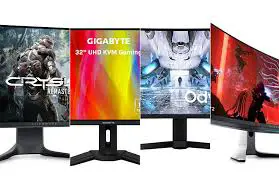Are you considering purchasing a new monitor and wondering how big is a 27 inch monitor? Well, you’ve come to the right place. Monitors come in various sizes, and it can be challenging to visualize how a particular size will fit in your workspace.
In terms of actual dimensions, the size of a 27-inch monitor can vary slightly depending on the aspect ratio (the ratio of the width to the height of the screen). However, for a standard 16:9 aspect ratio, which is common for most monitors, the approximate dimensions of a 27-inch monitor would be around 23.5 inches (59.7 cm) in width and 13.2 inches (33.5 cm) in height.
In this blog post, we’ll explore the dimensions and features of a 27 inch monitor to help you determine if it’s the right size for your needs.
Measuring monitor size

When it comes to measuring the size of a monitor, there are a few different measurements you can use. The most common measurement is the diagonal screen size, which is typically given in inches.
To measure the diagonal screen size, you’ll need to measure from one corner of the screen to the opposite corner. This measurement gives you the total length of the diagonal line across the screen.
Another measurement you may see is the aspect ratio, which is the ratio of the width to the height of the screen. This measurement is typically expressed as two numbers separated by a colon, such as 16:9 or 4:3.
It’s worth noting that the diagonal screen size and the aspect ratio are not the only factors that determine the actual physical size of a monitor. Some monitors have larger bezels (the frame around the screen), which can make the overall size of the monitor larger even if the screen size and aspect ratio are the same. Additionally, some monitors are curved, which can affect how you perceive the size of the screen.
Overall, when you’re looking to measure the size of a monitor, the diagonal screen size is the most important measurement to consider. However, it’s worth looking at other factors like aspect ratio and bezel size to get a better sense of the overall physical size of the monitor.
Understanding screen dimensions
Understanding screen dimensions is important when it comes to buying a monitor or a TV. Screen dimensions are typically expressed as two numbers: the width and the height of the screen.
For example, a screen with dimensions of 1920 x 1080 means that the screen is 1920 pixels wide and 1080 pixels tall. The total number of pixels on the screen is the product of these two numbers, which in this case is 2,073,600 (1920 x 1080).
It’s worth noting that the aspect ratio of the screen can affect how these dimensions are expressed. For example, a screen with an aspect ratio of 16:9 will have different dimensions than a screen with an aspect ratio of 4:3, even if both screens have the same number of pixels.
When buying a monitor or a TV, it’s important to consider the screen dimensions in relation to the size of the screen. A larger screen with the same resolution as a smaller screen will have fewer pixels per inch (PPI), which can result in a less sharp image. Similarly, a smaller screen with a higher resolution than a larger screen will have more PPI, which can result in a sharper image.
Overall, understanding screen dimensions is important when it comes to buying a monitor or a TV, as it can affect the overall image quality and sharpness of the display.
What is a 27 inch monitor?
A 27 inch monitor typically refers to the size of the screen measured diagonally from one corner to the opposite corner. It is a popular size for computer monitors, especially for gaming and productivity purposes.
Monitors of this size usually have a resolution of 2560×1440 or 1920×1080 pixels, although there are also some ultra-wide models with higher resolutions available. They can come in different types such as LED or LCD and can have various features like built-in speakers, adjustable stands, and multiple input options.
Physical dimensions of a 27 inch monitor
A 27-inch monitor typically refers to the diagonal measurement of the screen from one corner to the opposite corner. However, to understand the physical dimensions of the monitor, we need to consider its length, width, and thickness.
The length and width of a 27-inch monitor can vary depending on the aspect ratio of the screen. Most modern monitors have a widescreen aspect ratio of 16:9, which means that the length is 16 units for every 9 units of width.
Assuming a standard widescreen aspect ratio of 16:9, the length of a 27-inch monitor would be approximately 23.5 inches, while the width would be approximately 13.2 inches.
The thickness of the monitor can also vary depending on the design and model. However, most monitors are relatively thin, with a thickness ranging from 1 to 3 inches.
Overall, the physical dimensions of a 27-inch monitor would be approximately 23.5 inches in length, 13.2 inches in width, and 1 to 3 inches in thickness.
Screen resolution of a 27 inch monitor
The screen resolution of a 27-inch monitor can vary depending on the model and manufacturer. However, most 27-inch monitors have a resolution of 2560×1440 pixels, also known as QHD (Quad High Definition).
Some higher-end models may have a resolution of 3840×2160 pixels, also known as 4K Ultra High Definition. It’s important to note that the screen resolution alone doesn’t determine the overall picture quality, as factors such as panel type, color gamut, and contrast ratio can also affect the viewing experience.
The pixel density of a 27 inch monitor
The pixel density of a 27-inch monitor depends on its resolution and can vary from model to model.
For a 27-inch monitor with a resolution of 2560×1440 pixels (QHD), the pixel density would be approximately 109 pixels per inch (PPI).
For a 27-inch monitor with a resolution of 3840×2160 pixels (4K UHD), the pixel density would be approximately 163 PPI.
Higher pixel density generally means sharper and more detailed images, but it also requires higher processing power from the computer to display the content. It’s worth noting that the optimal pixel density for a monitor also depends on factors such as viewing distance and personal preference.
The aspect ratio of a 27 inch monitor

The aspect ratio of a 27-inch monitor can vary depending on the model and manufacturer. However, most 27-inch monitors have an aspect ratio of 16:9, which means that the width of the screen is 16 units for every 9 units of height.
This aspect ratio is commonly used for multimedia and gaming displays as it provides a wider screen that can display more content and provide a more immersive viewing experience. Some monitors may have a different aspect ratio, such as 21:9 or 4:3, but these are less common for 27-inch monitors.
Common uses for a 27 inch monitor
A 27-inch monitor is a popular size for many different uses due to its larger screen size and high resolution.
Some common uses for a 27-inch monitor include:
- Gaming: Many gamers prefer larger displays for an immersive experience. A 27-inch monitor provides a larger viewing area and better resolution, which is beneficial for gaming.
- Productivity: For professionals who require a larger screen to view multiple windows at the same time, a 27-inch monitor can be very useful. The additional screen space can help with multitasking, and the high resolution can make text and images appear sharper.
- Video and Photo Editing: A 27-inch monitor provides a larger screen area that can be beneficial for editing videos or photos. The high resolution of a 27-inch monitor makes it easier to see details in images or videos, and can help with color accuracy.
- Entertainment: For those who enjoy watching movies or streaming videos, a 27-inch monitor can provide a cinematic experience with its larger screen size and high resolution.
Overall, a 27-inch monitor is versatile and can be used for a variety of purposes, from gaming and entertainment to productivity and creative work.
Differences between a 27-inch monitor and other sizes
There are several differences between a 27-inch monitor and other sizes. Here are some of the key differences:
- Screen size: A 27-inch monitor is larger than many other sizes, such as 24-inch or 22-inch monitors. This can provide a larger viewing area and more screen real estate for multitasking, gaming, and productivity.
- Resolution: A 27-inch monitor often has a higher resolution than smaller monitors, which means that the pixels are more densely packed. This can result in a sharper image and better color accuracy.
- Price: Generally, larger monitors tend to be more expensive than smaller ones, so a 27-inch monitor may be more costly than a 22-inch or 24-inch monitor with similar specifications.
- Viewing distance: Due to its larger size, a 27-inch monitor may require a greater viewing distance than a smaller monitor to achieve optimal viewing. This can impact the overall viewing experience, especially for those with limited desk space.
- Compatibility: Depending on your computer’s graphics card and connection ports, a 27-inch monitor may require different cables or connectors than smaller monitors.
Overall, a 27-inch monitor can provide a more immersive and productive experience due to its larger size and higher resolution, but it may come at a higher cost and require a greater viewing distance.
Choosing the right size monitor for your needs
When choosing a monitor, it’s important to consider your needs and usage to determine the appropriate size.
Here are some factors to consider:
- Desk space: The size of your desk will dictate the maximum size of monitor you can comfortably use. If you have limited desk space, a smaller monitor may be more suitable.
- Purpose: The purpose of the monitor can also influence the size you need. If you’re using the monitor for work purposes, a larger monitor may be more beneficial for multi-tasking and productivity. If you’re using the monitor for gaming or entertainment, a larger screen can enhance the overall experience.
- Distance: The distance between you and the monitor can also determine the size you need. If you’re sitting close to the monitor, a smaller screen size may be better to avoid eye strain. If you’re sitting further away, a larger monitor may be more appropriate.
- Resolution: Higher resolutions require a larger monitor to display more content without reducing the clarity. For example, if you’re using a monitor with a 4K resolution, a larger screen size would be necessary to take advantage of the increased pixel density.
- Budget: Monitor prices increase with size, so it’s important to consider your budget when determining the appropriate size.
Ultimately, the size of the monitor you choose will depend on your specific needs and preferences. Consider these factors and choose a size that best suits your usage and budget.
Display options for a 27 inch monitor

There are several display options for a 27 inch monitor. Here are some of the most common:
- Resolution: A 27 inch monitor typically has a resolution of 2560 x 1440 (WQHD) or 3840 x 2160 (4K UHD). The higher the resolution, the clearer the image will appear.
- Panel type: There are three main types of panels used in monitors – TN, IPS, and VA. TN panels have faster response times and are typically used for gaming monitors, while IPS panels have wider viewing angles and better color accuracy. VA panels have the highest contrast ratios.
- Refresh rate: The refresh rate is the number of times per second the monitor updates the image. A higher refresh rate (such as 144Hz or 240Hz) can provide smoother motion and reduce motion blur.
- Adaptive Sync: Adaptive Sync technology (such as AMD FreeSync or Nvidia G-Sync) can help reduce screen tearing and stuttering in games by syncing the monitor’s refresh rate with the graphics card’s output.
- HDR: High Dynamic Range (HDR) can provide a wider range of colors and higher contrast for a more immersive viewing experience.
When choosing a display option for your 27 inch monitor, consider your usage and preferences. For example, if you’re a gamer, a monitor with a fast refresh rate and Adaptive-Sync technology may be more important than color accuracy. If you’re a graphic designer, a monitor with an IPS panel and high color accuracy may be more suitable.
Mounting options for a 27 inch monitor
There are several mounting options for a 27 inch monitor, depending on your workspace and preferences. Here are some of the most common:
- Desk mount: A desk mount is a clamp or base that attaches to the desk and allows the monitor to be mounted on an arm or pole. This option is great for those who want to save desk space and have more flexibility in adjusting the monitor’s height and angle.
- Wall mount: A wall mount is a bracket that attaches to the wall and allows the monitor to be mounted like a picture frame. This option is great for those who want to save desk space and have a cleaner setup, but it’s important to make sure the wall can support the weight of the monitor.
- Stand: Many monitors come with a stand that allows them to be placed on a desk or table. This option is great for those who don’t want to mount their monitor and want a simple setup.
- VESA mount: A VESA mount is a standardized mount that allows the monitor to be attached to a compatible arm or stand. This option is great for those who want to use a third-party mounting solution and have more flexibility in choosing the mount.
When choosing a mounting option for your 27 inch monitor, consider your workspace and how you plan to use the monitor. Desk mounts and VESA mounts offer more flexibility and adjustability, while wall mounts offer a cleaner setup but require more installation work.
Recommended:
- How much does drywall weigh?
- How big is 600 square feet?
- How big is 700 square feet?
- How big is 1200 square feet?
- How wide should a shoe shelf be?
Comparing 27 inch monitors from different brands
When comparing 27 inch monitors from different brands, there are several factors to consider. Here are some of the most important:
- Display panel: Different brands use different types of display panels, such as TN, IPS, and VA. Each panel type has its own strengths and weaknesses, so it’s important to choose one that suits your needs.
- Resolution: 27 inch monitors typically have a resolution of 2560 x 1440 (WQHD) or 3840 x 2160 (4K UHD). Higher resolutions provide clearer images, but they may also require more powerful hardware to drive them.
- Refresh rate: The refresh rate is the number of times per second the monitor updates the image. A higher refresh rate (such as 144Hz or 240Hz) can provide smoother motion and reduce motion blur.
- Adaptive Sync: Adaptive-Sync technology (such as AMD FreeSync or Nvidia G-Sync) can help reduce screen tearing and stuttering in games by syncing the monitor’s refresh rate with the graphics card’s output.
- Price: Monitors from different brands may vary in price, so it’s important to choose one that fits your budget.
- Brand reputation: Different brands have different reputations for quality and customer support. It’s important to research each brand before making a purchase.
When comparing 27 inch monitors from different brands, consider the above factors and choose the one that best fits your needs and budget. It’s also a good idea to read reviews and compare specs to ensure that you’re getting the best value for your money.
Conclusion
A 27 inch monitor is a popular size that offers a good balance between screen real estate and desk space. It’s large enough to provide a clear and immersive viewing experience, but not so big that it takes up too much room on your desk.
When choosing a 27 inch monitor, consider factors such as display panel type, resolution, refresh rate, adaptive sync, price, and brand reputation to find the one that best suits your needs. So, if you’re wondering “how big is a 27 inch monitor,” it’s big enough to provide a great viewing experience without overwhelming your workspace.

